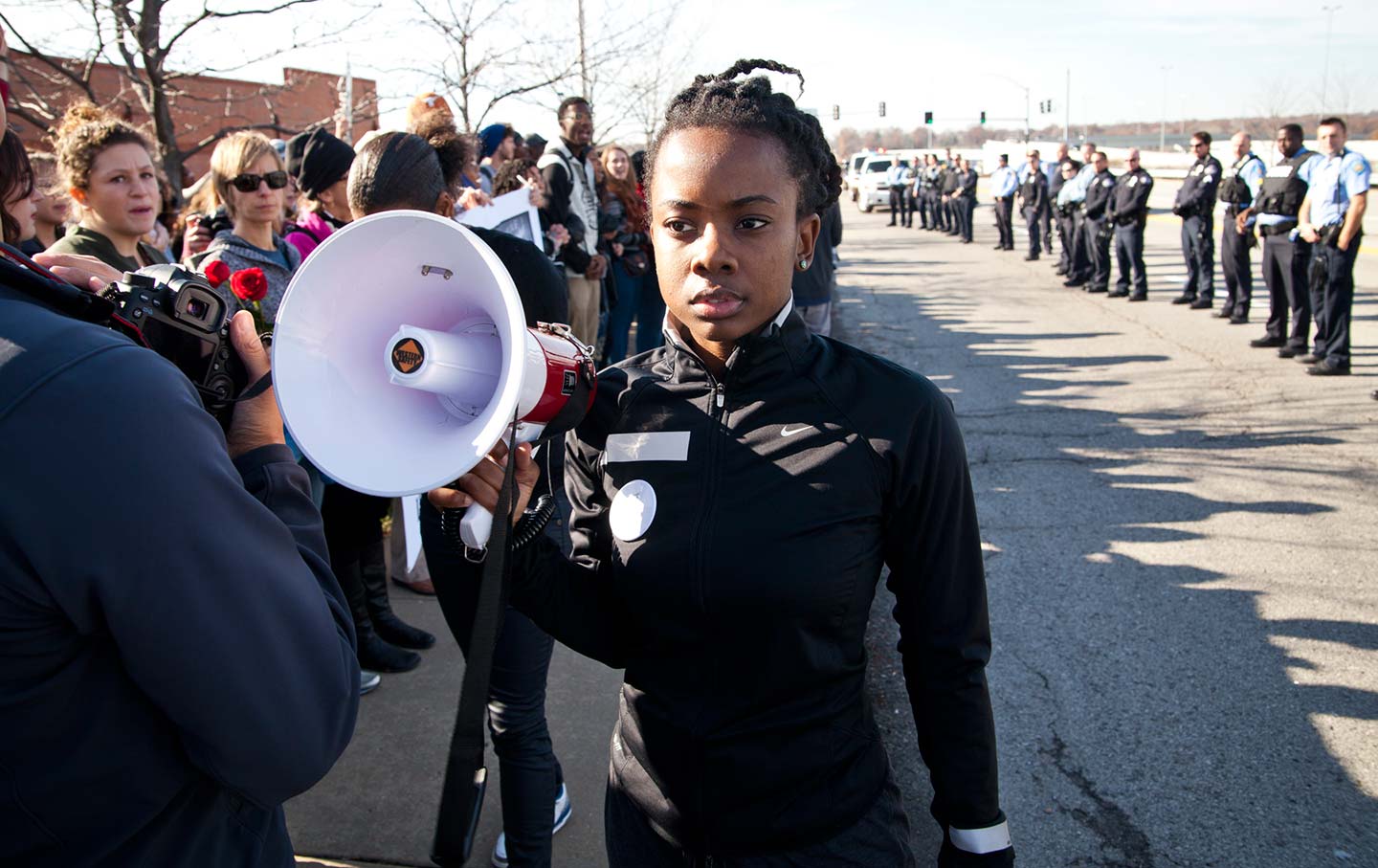
Activist Brittany Ferrell in the documentary film Whose Streets?(Courtesy of Magnolia Pictures)
Overt, explicit racism—not the kind that hides itself within prisons and school systems—has taken our country hostage. Having hundreds of neo-Nazis and white supremacists stalk American streets, shamelessly, freely, in their pressed Dockers, has changed what racism looks and feels like. And it’s rocked what and where the progressive fight is. Instead of trying to end mass incarceration and fighting to integrate schools, our attention has shifted to delegitimizing ethno-nationalist rhetoric and white supremacist rhetoric ideology.
The constantly shifting and frenetic urgency of everyday life under Trump makes one forget about the urgency of three years ago, when the body of an 18-year-old black boy named Michael Brown—who was shot and killed by a white police officer named Darren Wilson—was left in the streets of Ferguson, Missouri, for hours. That urgency coalesced into a new movement that sought to end indiscriminate killings of black Americans by law enforcement—and provided a gut check about the harm a militarized police force can inflict upon a community in protest.
In 2015, just months after protesters in Ferguson were surrounded by tanks, hit with rubber bullets and tear-gassed, President Obama signed an executive order that stopped the federal government from giving military-grade weapons and vehicles to local police forces. But on Monday, Jeff Sessions announced that the federal government will again send surplus military equipment, like high-caliber weapons, grenade launchers, and armored vehicles, to Main Streets across America.
Last week, Whose Streets?, a documentary film by filmmaker and activist Sabaah Folayan about Brown’s death and the uprising that followed, was released in theaters across the country. Watching it was an altogether strange experience in the era of Trump: a reminder of a moment filled with so much anger, despair, violence, but one with a kernel, too, of hope. The documentary centers around three activists: Tef Poe, a black rapper and musician; Brittany Ferrell; and David Whitt, a local cop watcher. All three of them talk about the near-constant discrimination they witness and experience, but the film also shows how empowering organizing is for each of them. In a poignant moment, Ferrell marries her girlfriend, whom she met during the uprising in Ferguson.
The film also captures how fury over Michael Brown’s death went far beyond Ferguson. The city became a flashpoint, a symbol for just how widespread police violence against black Americans really was. One Ferguson resident says of the moment protesters began pouring into the streets, “There was no fear in the heart of people anymore.”
But watching this film months after the footage was collected, with Trump in the White House, can leave you feeling sick. Where there once was a fire inside people, now, it seems, there is a dim light. Most troubling is the suspicion that it was the very organizing and protests in Ferguson sparked the “All Lives Matter” and “Blue Lives Matter” backlash that, in part, brought us the intensely racially polarized America we find ourselves in today.
Watching the documentary forces the viewer to contrast the hopeful, if at times cynical, activism of then with the hopelessness of now. In one interview a black Ferguson resident expresses how disappointed he was with Obama’s response to the Ferguson protests, and sarcastically questions whether Obama really was our first black president. (It was odd to find myself nostalgic for a time when a black man could lament the inadequate response of a black president.) But that interviewee wasn’t alone; during his presidency, Obama was sharply criticized for not being forceful enough of his condemnation of police killings of black Americans. After the grand jury failed to indict Darren Wilson, Obama gave a speech calling on the public to respect the grand jury’s decision and the judicial process. In hindsight, it’s painfully apparent how much stronger white supremacy is than Obama’s individual power was. As the first black president—whose birthright was questioned, who was accused of being a Muslim—Obama had good reason to avoid rocking a boat that, if tipped, could sink him. If that wasn’t obvious to all during his presidency, it’s clear as day under Trump.
And then there is the fear of what we have yet to experience under Trump. In a later scene, Attorney General Eric Holder announces a Department of Justice investigation into whether the city of Ferguson discriminates against its poor black population. The findings of that investigation, of course, were conclusive: From racist e-mails sent by police to the stunning revelation that 67 percent of Ferguson’s black residents accounted for 93 percent of arrests in 2012–14, Ferguson did discriminate against its black population. The Obama administration told America, in no uncertain terms, that Ferguson had a race problem. With its emphasis on preserving “law and order” in urban communities, the Trump administration is doing the opposite.
In one scene, a young Ferguson resident and protester named Dhoruba opens a bag to reveal the remains he had collected of rubber bullets and other military-grade weapons used on him and other protesters. It’s a haunting moment, not just because he had a bag full of weapons that police used on their own people. But also because with Trump in power, who will protect us now?
Collier MeyersonTwitterCollier Meyerson is a Knobler Fellow at the Nation Institute, where she focuses on reporting about race and politics, and an investigative fellow at Reveal.